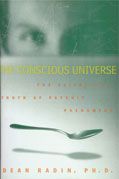|
The Conscious Universe is Dean Radin's first major book publication on the subject of psychic phenomena (or simply, "psi"). It is a breathtaking survey of a broad scientific literature that is current up to its publication date. Radin has a Ph.D. in psychology from the University of Illinois in Urbana-Champaign, and this book clearly reflects his training as an empirically-based scientist. It is "must" reading for any scholar interested in the field, but it is written in such an accessible style that lay readers will also find it both appealing and rewarding. Radin begins his discussion with an explanation of psi, and he explains why the phenomenon is appropriate for scientific inquiry. He then discusses the scientific issue of replication both in terms of the need for it and possibility of doing it. There are essentially two dominant approaches to the study of psi. The first is to analyze data involved in an experiment. The second is to analyze the data and results of many published scientific studies, the so-called "analysis of analyses." The first approach is the one with which most people are familiar. The second approach is called "meta-analysis," and it is sometimes used in order to draw conclusions that are less tied to a specific experiment and more tied to the overall phenomenon. Meta-analysis can involve an analysis of hundreds of studies, so issues of statistical significance gain greater traction. Radin explains this entire subject with unusual clarity. Radin then moves into various themes that often appear in the scientific study of psi. This includes telepathy, remote viewing, perception across time, psychic interactions with both inanimate matter and living organisms, and even the application of psi with respect to gambling. He also discusses the idea that groups of humans may be able to form a field of consciousness, sometimes called a "collective consciousness." It is essential to note that Radin does not discuss these ideas metaphorically, or even loosely. Rather, he constantly connects these topics to concrete analyses of hard data that originate from respected laboratories spanning a variety of countries. He explains scientific results that are obtained by a diverse colletion of primary researchers using accessible language, and then outlines the significance of these results. A lot of statistics are involved in this type of research, and some of the statistics are quite advanced and occasionally intimidating. But Radin makes it all understandable to both scholars and lay readers alike. Radin does not shy away from the arguments of skeptics. Rather, he devotes more than a few pages explaining the commonly voiced opposition to the reality of psi. Without dismissing any negativist arguments out-of-hand, Radin carefully outlines the critical weaknesses of the debunking themes. It is difficult to read Radin's discussion of the scientific skepticism with respect to psi without wondering why the debunking myths have lasted so long. Yet disbelief in the reality of psi remains so widespread among the majority of the scientific community despite overwhelming evidence to the contrary that one is left wondering if there is something deeply wrong in the approach that Western society takes to training its scientists. For many skeptics, credible scientific investigations into psi become ventures into forbidden thought. But should any thought be forbidden if science is to remain truly scientific? The skeptic's universe is complex, and it helps to have Radin's solid background in psychology to sort it all out. Radin concludes his book with a wide-angle lens with which he discusses both the theory and scientific implications of psi. While his overview of theory is appropriate for a survey book of this sort, it does not match the depth that he achieves in his second book on psi, Entangled Minds: Extrasensory Experiences in a Quantum Reality. Nonetheless, his discussion in The Conscious Universe of a scientific theory capable of establishing a physical mechanism for psychic functioning is the appropriate first step along this road, and readers are encouraged to absorb it. In sum, Dean Radin's book is a solid review of the science of psychic phenomena. It should be read by anyone interested in the field, be they academics with a background in empirical science or lay people with a more casual interest in the subject. This book is much more than just an entry point to a sophisticated literature. It organizes a diverse literature into a coherent field with a clarity that is rare in any science. College students in particular will want to read this volume with care. |

